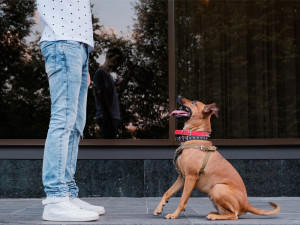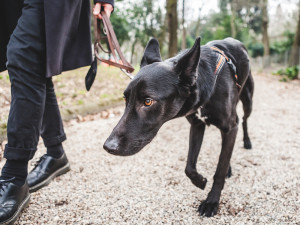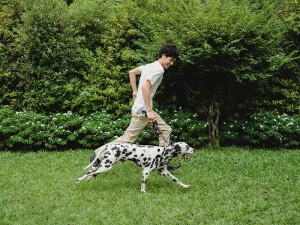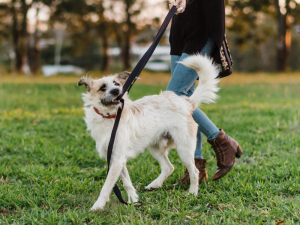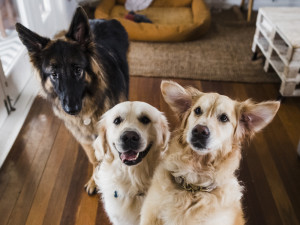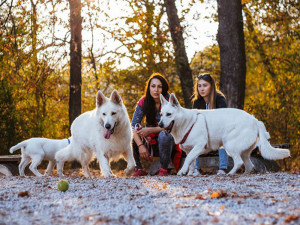8 Reasons Your Dog is Standing on You and What to Do About It
Oh, hey, bud. Wasn’t expecting that.
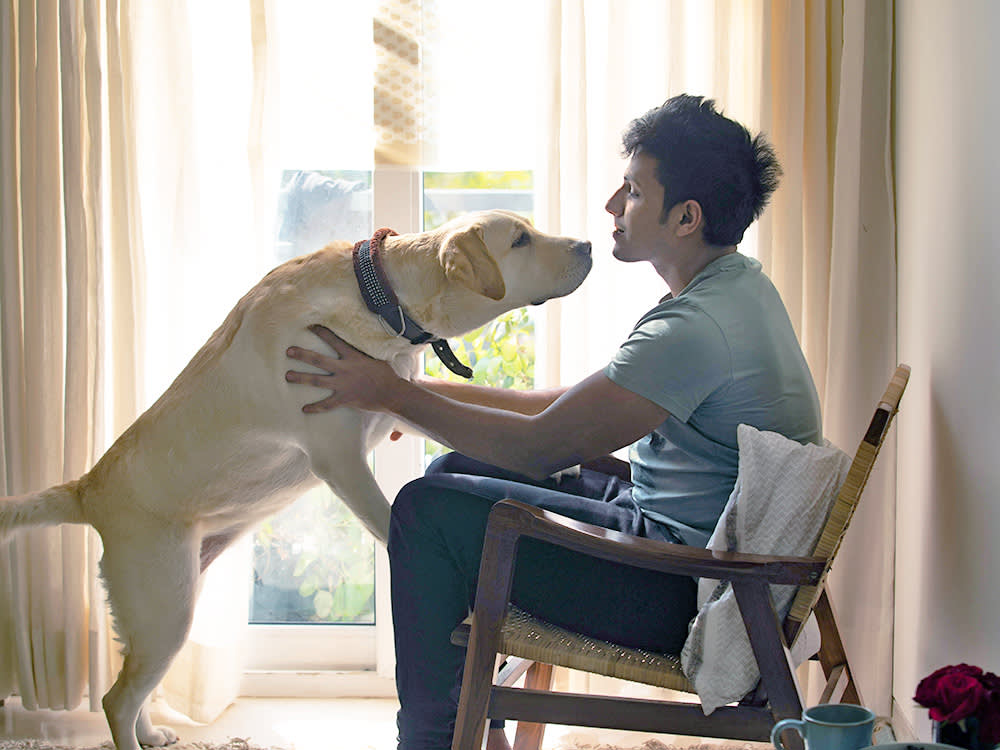
Share Article
In This Article:
8 Reasons Why Your Dog is Standing on You What Should You Do About Your Dog Standing On You?
Often in the morning I hear the bedroom door fling open and see a feathery tail cruise past the foot of the bed like a shark fin. Next thing I know, my Collie mix, Willy, has jumped on the bed and is standing on my body, wagging his tail. He feels like a weighted blanket. His littermate, Lilac, doesn’t do this, so why does he? I take it as a cue to give him attention then get up to let him out.
Susan Nilson, an accredited behavioral specialist, says my response reinforces Willy’s behavior. Nilson founded The Cat and Dog Houseopens in new tab to help pet parents understand their pets’ behavior. She says dogs learn quickly that they’ll get attention if they stand on you. That can be a pat on the head, a laugh or even verbal redirection. “Regardless of what the response is (i.e., positive or negative), it can reinforce the behavior,” she says. “Understanding why your dog stands on you involves considering his unique personality, early learning and life experiences and overall emotional needs.”
If they’re panting in your face or their sharp nails are digging into you, it can be annoying when your dog stands on you. Discourage your dog from standing on you by redirecting them to sit next to you or lie on the floor. Give them a reward when they do. Engage in training and obedience to learn cues like “off” or “down” and “leave it” that can accompany redirection. Create inviting spaces for them to relax so they're less likely to stand on you.

Eight reasons why your dog is standing on you
They are seeking attention.
Dogs often learn that standing on their owner gets a reliable reaction (Willy, we’re looking at you). For example, if a dog receives a scratch behind the ears every time they stand on their owner, Nilson says they’re likely to keep repeating the behavior to get that same reward.
“Even if you push your dog away, or ask them to get off, in your dog’s eyes that’s still attention so you’re reinforcing the behavior even if you don’t intend to do so,” she says.
They are anxious.
Thunderstorms, fireworks, unfamiliar house guests or sudden changes in a dog’s environment will trigger anxiety. “Some dogs stand on their owners as a way of seeking comfort when they feel anxious or scared,” Nilson says. “Studies show that dogs, just like children with their parents, use their owners as a secure base. By maintaining close physical contact it can provide them with a sense of security and safety.”
Pay attention to your dog’s body language; if their ears are down and their tail is tucked, they’re anxious or afraid of something.
They love you.
Dogs are highly social animals and often express their affection physically, Nilson says. “Standing on you could simply be a way for your dog to show his affection and maintain that close bond,” she says.
That physical connection can also prompt the release of oxytocin in both of you. Oxytocin is sometimes called the “cuddle hormone” or “love hormone” because it promotes feelings of happiness, love and connectedness. “So when your dog stands on you, he most likely experiences a boost in those feel-good hormones,” Nilson says. “This positively reinforces his desire to be physically close to you and, again, he's likely to keep repeating the behavior.”
They are being protective.
Some dogs are genetically more protective than others. Some have also been trained to be protective. They instinctively guard precious resources, like food, toys, bones, their bed, and even their pet parents, Nilson says.
“Certain breeds like German Shepherds and Dobermanns for example, were bred specifically for guarding so may have a natural predisposition to stay close to their owners and protect them,” she says.
What if your dog is snapping and growling at someone else while standing on you? That means your dog is being over-protective. If unchecked, this behavior can escalate and should be addressed by a vet or behaviorist.
They have separation anxiety.
Separation anxiety is common in dogs, with studies reporting opens in new tab that up to 75 percent of dogs in the United States experience it to some extent, Nilson says. “Dogs with separation anxiety often cling to their owners physically, even when they’re present,” she says. “Standing on you might be part of a wider pattern of behavior that includes following you around or becoming distressed when you’re out of sight, even for just a few seconds.”
They are showing dominance.
Nilson like other vets and behaviorists, says dominance is a debunked myth. “The outdated (and inaccurate) notion of ‘dominance’ in dogs was based on a study of unrelated captive wolves and then erroneously applied to pet dogs. It has since been widely debunked by modern behavioral science, although the myth persists,” she says. “Your dog standing on you is not a sign he’s trying to ‘dominate’ you or be the ‘alpha’ dog or ‘pack leader.’ Rather, it’s simply rooted in his need for comfort, attention, or connection.”
They are being playful.
Dogs will use physical contact to invite play with other dogs. In the “play bow” position, a dog’s butt is in the air, its tail is wagging and its mouth is open. “If your dog is feeling playful or excited, he may jump up, put his front paws on you or even stand in your lap to get your attention and try to initiate a play session,” Nilson says.
They or you are sick.
Dogs are highly perceptive creatures adept at reading human body language and sensing something is wrong before we know it ourselves. That’s why dogs, with their superior sense of smell, are trained to detect cancer. Cancer cells, even those that have not spread from their initial site, produce a specific odor dogs identify on human breath.
Nilson says dogs sense changes in the people around them. “This includes picking up on cues (via changes in demeanor and behavior) when their owners are unwell,” she says. “If you’re feeling under the weather, your dog might stand on you or lean against you to offer comfort or stay close as a protective gesture.”
We’ve heard wild animals retreat if they’re sick or injured. If your dog is sick or in pain, they’re likely to do the same. They might exhibit behaviors like hiding, decreased activity, lethargy, lack of appetite or withdrawal. Others however, Nilson says, may become unusually clingy or irritable (and even aggressive). “Having said that, some dogs may still seek comfort by staying close or leaning against their owners for reassurance,” she says.
What should you do about your dog standing on you?
Gently push them off you with a firm “no” if you don’t want them standing on you. But if your dog is standing on you for attention, and you think it’s cute and give them a scratch, you’ll teach them standing on you yields rewards (like Willy when he wants to go out in the morning).
Learn your dog’s body language. If their front paws are on your legs, and they’re wagging their tail, they probably want to play. If your dog is persistently standing on you and exhibiting signs of anxiety (tucked tail, furrowed brow, lowered ears) they’re communicating fear or anxiety.
Bottom line
Dogs stand on people to get attention and communicate affection and playfulness.
They also stand on people to seek reassurance when they’re scared, anxious, sick, or injured.
Giving your dog attention when they stand on you will reinforce the behavior.
FAQs
How can I get my dog to stop standing on me?
In general, it’s a good idea to discourage your dog from standing on you. Redirect them with positive reinforcement, train them to lie or sit next to you instead or ignore them. Turn your body away, don’t make eye contact or reward them with physical interaction.
Will my dog stand on other people?
If your dog has learned to stand on you, they may also try to stand on other family members and guests. Not everyone likes this. It can also be dangerous or frightening. If you can’t prevent your dog from standing on guests, you may need to remove them (your dog, not your guests) to a crate or another room.
When should I call a vet if my dog is standing on me?
If your dog is standing on you and growling, snapping or exhibiting other hostile behavior, seek advice from a vet or behaviorist. Your dog might be protecting you but aggressive behavior and over-protectiveness can lead to bigger issues and even injury. It can also be a sign of underlying issues such as fear or illness.
Why does my dog stand on me?
Your dog stands on you because they want attention, they’re anxious, they’re demonstrating affection or they’re feeling playful. They can also stand on you if they’re feeling protective or sense you’re sick.
Is it OK for my dog to stand on me?
A lot of people think it’s cute when their dog stands on them and will reinforce the behavior with exclamations of delight (this might be especially true of people with small dogs). If the behavior is annoying to your or other people in your house, you can train your dog not to stand on you.
What can I do if I don’t like my dog standing on me?
Don’t overreact. Gently and firmly discourage your dog from standing on you by redirecting them to sit next to you or lie on the floor. Offer a favorite treat or reward when they obey.
References
Mary Robins, et al. “Dogs Detecting Disease: Meet America’s Cancer-Sniffing Canines.” American Kennel Club, 25 Mar. 2020, www.akc.org/expert-advice/news/meet-americas-cancer-sniffing-canines/opens in new tab.
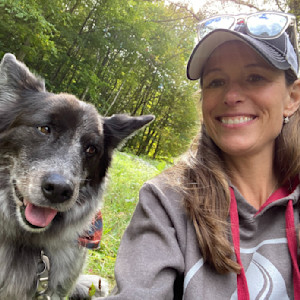
Catherine Fahy Green
Catherine Fahy Green is a journalist turned copy and content writer. As a pets writer, she focuses on and is fascinated by animal body language because there's so much to learn from and about animals by spending time in their presence and observing their physical cues.
Her work as a PR specialist appears in national trade media as press releases and stories about exciting new products people should try. She lives with her family in Western Massachusetts, where she listens closely to the stories her two dogs, flock of chickens, and four horses tell her. She spends her weekends at horse shows with her daughter.
Related articles
![Man running with dalmatian dog on a leash in a backyard with grass]()
An Active Dog Is a Well-Behaved Dog
Why regular exercise can mean a less destructive dog and a happier you.
![weird dog rolling in poop]()
7 Weird Dog Behaviors Explained
Chasing their tails, eating grass, and rolling in garbage — should you worry?
Are You to Blame for Your Dog’s Behavioral Issues?
You may have wondered if you're the one causing the problem.
![Scruffy dog tugging on leash as owner is pulling it]()
How to Change the Way You Think About Your Dog’s Behavior
Instead of focusing on the negatives, here’s what you should do instead.
![3 dogs posed together in a house]()
Does Your Dog Have a Unique Personality?
Yep, research says your dog is as special and perfect as you tell them they are.
![two woman at dog park talking while watching their dogs play]()
13 Common Dog Behavior Myths Overheard at Dog Parks
Many pet parents share information at the dog park, but is the information always accurate?
